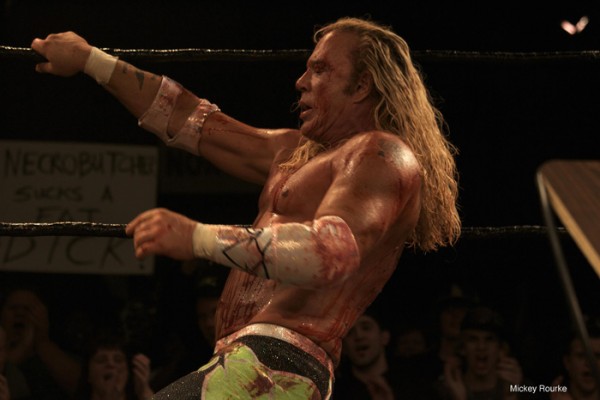The Wrestler Continues Aronofsky’s Exploration of Obsession and Addiction
The Wrestler
Directed by Darren Aronofsky
Written by Robert D. Siegel
Fox Searchlight, 2008
Darren Aronofsky hit the scene in 1998 with Pi, a look into a man’s obsession with numbers and their hidden meaning. Ever since, Aronofsky has been hitting this trail, most notably with Requiem for a Dream, which dealt with all the forms of drug use imaginable. A couple of years ago, he made his most ambitious (and most flawed) attempt with The Fountain, in which a man spends a lifetime and then some to find a cure for his wife. Now, he offers The Wrestler, a movie that fits his themes more perfectly than his previous efforts.
At first, it doesn’t seem that way. In fact, The Wrestler seems entirely different at first. It seems merely to be the simple story of a man struggling with life, and we just see a small-town guy trying to make a living. But somewhere in the middle of it all, it becomes pure Aronofsky…with an ending that is absolutely perfect.
Former big-time wrestler Randy “The Ram” Robinson (Mickey Rourke) is now relegated to a lesser-known, but highly brutal league and works a second job at a deli. He frequents stripper establishments, hitting up his favorite, Cassidy (Marisa Tomei, still slammin’ at 44, and frequently nude which is a bonus) whenever he can. He lives his wrestler persona on the edge: As was discussed in the wrestling documentary Beyond the Mat, wrestling may indeed be “fake,” as in “rehearsed,” or “stretching the truth,” but the fact is, these wrestlers get hurt a lot. And in this league, the “CZW,” the whole gamut of extreme tactics are used: think barb wire and razors and stuff. In one brutal stretch, the aging Ram abuses his body for really not that much money, and he suffers a heart attack. It’s time to move on with life without wrestling.
So he tries to make good with his estranged daughter Stephanie (Evan Rachel Wood), and tries making a play for Cassidy, who is also a single mom. He subtly tries making the deli job more of a performance piece, trying to win back a little of the adoration he got in the ring. But damaged characters are destined to have the mightiest struggle at getting into a “normal” life, and the question of the film becomes, “Will he break or won’t he?” Let’s not forget that the CZW is looking for him to un-retire.
Mickey Rourke, who made a sort of comeback in Sin City, is fantastic as The Ram. His life probably is closer to The Ram than we can imagine, and he takes advantage. It is method acting that relies on decades of experience, including his retirement from acting to become a boxer, his arrest for spousal abuse, a DUI, and a lifetime of cultish roles. I always thought he resembled and sounded like Bruce Willis, especially if Willis decided to take a detour from acting and “live it up” like Rourke has.
Meanwhile, Aronofsky explores, perhaps for the first time in stark detail, why someone would brutalize themselves in such a way. This is obsession just like anything else: why would you willingly allow people to beat you up in a ring for so little money? Blood is the addiction here; the sight of it and the reaction it causes. In his previous three films, Aronofsky focuses on the obsessions and their awful consequences, but we don’t come to much of an understanding, not that this was in any way a flaw. It’s just that with the slightest bit of explanation, and like I said, that unforgettable ending, it ties together better than any of his other previous flicks.
Aronofsky has a small film with a dynamite punch here. Here’s hoping it finds a sizable audience.
Comments
Write a comment
You must be logged in to post a comment.

Comment from KW
Time: October 24, 2008, 2:02 pm
In the span of about a week, I’ve gone from never having heard about this movie to wanting to see it quite badly. Every review is a rave.